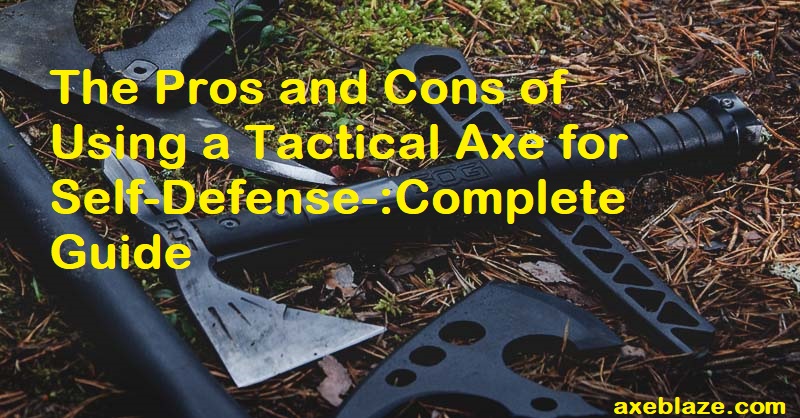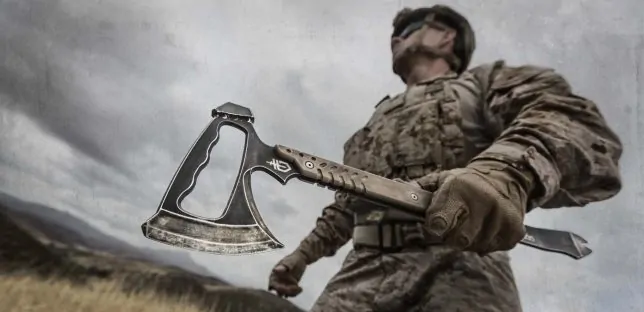Are you looking for the best self-defense tool? Perhaps consider a tactical axe! With its sharp blade and solid steel construction, it can prove to be a formidable asset.
But don’t just rush in, here’s everything you need to know about the pros and cons of using a tactical axe!
Welcome to this comprehensive guide on the pros and cons of using a tactical axe for self-defense. This guide will provide an overview of the general effectiveness of using a tactical axe as well as provide more detailed information about the various types of axes available and how to choose one that best suits your needs. Finally, this guide will cover safety precautions for those considering the use of a tactical axe in self-defense.
This guide is designed to give you enough knowledge to make an informed decision regarding whether or not a tactical axe is right for you. Whether you’re a survival enthusiast looking for an alternate form of defense or just curious about the subject, we hope this guide will help fill in any knowledge gaps you may have. Let’s get started learning about this powerful weapon system!

Explanation of what a tactical axe is
A tactical axe is a specialized tool designed for self-defense, often augmented with features that allow for ease of use and effective protection against an assailant. Tactical axes can range from full-size battleaxes to smaller versions designed more for concealment and portability. Most tactical axes include a sharpened edge, typically made from high-grade steel and boasting a Rockwell hardness rating of approximately 58HRC. These edges are intended to be quickly drawn in the event of an attack, allowing the user to strike at their target swiftly and accurately.
Tactical axes also come with a range of handle options, depending on the maker and the intended purpose. Common choices include a classic wooden handle, as well as polymer or composite materials like Kraton or G10. Handles may also feature Damascus accenting or other adornments to improve grip or provide additional aesthetic appeal. The length of most tactical axe handles is between 8 and 12 inches, but larger models may feature longer handles for enhanced reach during defense maneuvers.
Brief overview of the pros and cons of using a tactical axe for self-defense
Though it may seem intimidating at first, a tactical axe can be an invaluable tool to have in your arsenal for self-defense. It has the potential to provide more fatal results than more common self-defense methods, such as handguns or pepper spray, so it is important for potential users to understand the advantages and disadvantages of using a tactical axe before making the decision to employ one for his or her own safety.
The primary pros of using a tactical axe for self-defense are that it is extremely powerful and can quickly put down an attacker with one strike. Because of its size and weight, it also makes an effective deterrent even before making contact with an attacker as many criminals will likely be deterred by the sight of such a deadly weapon. Another benefit of employing this type of tool is that because axes are usually used only in cases of dire need, there are often very few legal restrictions which would prevent their use.
However, there are also many potential drawbacks to consider before deciding whether or not to pursue the use of a tactical axe for self-defense. Firstly, its power can easily lead to excessive force if not properly kept in check. Secondly, if one were actually charged with wielding an ax as part of a criminal offense or excessive force incident; conviction times could be severely increased due to its perceived level of severity. Additionally, improper training with such a weapon could result in injury and long term damage if used improperly making any attempt at self defense without proper instruction potentially counterintuitive effect on protection techniques.
In conclusion, while it may seem attractive at first due to its sheer power and lack of legal restrictions in many jurisdictions the decision whether or not one should employ the use tactical axed should not be taken lightly due to profound consequences associated with its misuse both legally and physically.
Pros of Using a Tactical Axe for Self-Defense
When discussing the advantages of using a tactical axe for self-defense, there are a few main points to consider. The most obvious is that it’s an incredibly effective tool for self-defense. Its long handle gives you better reach than most other weapons and its sharp blade allows it to penetrate through tough material, making it easier to disable an attacker if necessary.
In addition, having an axe allows you to quickly break down objects or barriers in order to escape or gain access to safety if needed. The weight and width of the head also allow for more powerful swings that can easily deter any attacker as well as break through doors or walls in order to reach safety. Moreover, having an axe with you can offer some additional psychological protection as it can be intimidating enough on its own just by having one readily available in case of danger.
Finally, the tactical axe is highly portable and easy to carry – this too adds an advantage over longer weapons like swords or spears and virtually no license is required (depending on location) making them easy to purchase when needed.
Ability to cause significant damage to an attacker
A tactical axe is a weapon that has long been used for self-defense, thanks to its ability to cause significant damage to an attacker. It is generally made from a solid piece of metal or wood and has a rounded, curved or serrated blade designed to penetrate and cause maximum damage. Unlike firearms, it does not require ammunition or need to be reloaded after each swing. Additionally, many models are reasonably priced and broadly accessible in most countries.
The primary advantage of using a tactical axe as a self-defense weapon is that it can easily penetrate through clothing and soft materials such as flesh and bone. Its intimidating look can also be an effective deterrent when used tactically. Depending on the model, some axes are relatively light-weight making them easier to wield with one hand while still containing enough mass to produce sufficient force upon impact. Also its compact form factor makes it easier to store in tight spaces such as underneath car seats or strapped onto the waistband of pants allowing its user accessible protection whenever needed.
Just like any other weapon however, there are some downsides when using a tactical axe for self-protection. It requires practice in order for its user to become proficient with it, especially if striking from multiple angles and distances is desired. Additionally since axes generally lack any form of built in safety features such as those found on firearms its user will need proper training in defensive techniques minimizing risks of infliction harm on oneself or bystanders if the decision is made use the axe against an attacker out of desperation or panic insteads of necessity.
Versatility in its use, including as a tool for other purposes
In addition to its self-defense capabilities, the tactical axe is a highly versatile tool. This makes it a great addition to any survival or emergency kit. It can be used for many different types of tasks such as splitting logs, chopping firewood, chopping kindling, cutting branches, building shelters, and even self-defense if needed.
The versatility of the tactical axe is one of its most attractive features because it’s not just for self-defense; it’s also an invaluable tool for many everyday tasks. It’s lightweight, easy to carry and durable so that you can have peace of mind that it will last you through whatever type of task you may need it for.
Additionally, this versatility also allows you to use the axe as a multi-purpose tool in addition to self defense if needed. With this invaluable tool close at hand in any survival or emergency situation you should rest assured knowing that your safety is taken care of due to its utility in various situations.
Intimidating appearance can act as a deterrent to potential attackers
Many people consider tactical axes a viable self-defense option, and their intimidating appearance can often act as a deterrent to potential attackers. The axe’s curved blade or sharp claw make it appear more menacing than a smaller blade, and its size allows for more forceful attacks. This can be particularly useful in close-quarters combat. As an improvised weapon, it has the advantage of being both intimidating and readily available in most homes or outdoors.
However, its use must be considered carefully due to the risk of serious injury or death that comes with using an axe in self-defense. Not only are precise strikes essential for success, but the wielder may find themselves facing legal consequences if their actions are deemed to be unlawful.
Therefore, prospective users should arm themselves with knowledge about relevant laws regarding self-defense before wielding an axe as a potential weapon against somebody else. Additionally, courses such as Krav Maga may include training on the proper way to handle tools commonly found inside or outside a home and enable users to develop skills with weapons they believe they may need to use if needed.

Cons of Using a Tactical Axe for Self-Defense
Using a tactical axe for self-defense is not without its drawbacks. This weapon may offer an intimidating presence in an emergency situation; however, its drawbacks should be considered before investing in one.
One of the main cons of using a tactical axe for self-defense is its potential to cause permanent damage if used inappropriately. Although training courses for proper usage are commonly available, mistakes can still be made due to fear, adrenaline or inexperience that can have lasting consequences. Additionally, due to their size and weight, users must be sure they have the strength and endurance to wield the tool safely and adequately in an emergency situation.
Tactical axes are also quite expensive to purchase and maintain. Not only do consumers need to purchase the tactical axe itself, but also require sheaths or holsters designed specifically to carry it securely and safely when not in use. An additional issue associated with these weapons is how easily they can become a target for theft or misuse if improperly stored or left unattended.
Finally, many local municipalities have laws regarding weapons such as blades and clubs that can affect owning a tactical axe for self-defense purposes. Users should familiarize themselves with local laws before purchasing this weapon as varying laws by state require permits or other restrictions on its use.
Requires significant skill and training to use effectively
Although a tactical axe is an effective self-defense tool, it requires more skill to use than many other self-defense tools. Its heft and unusual shape make it difficult to control unless used with great precision. Using a tactical axe requires practice and training before it can be used confidently in a self-defense situation. It may require expert instruction from qualified professionals as well as practice sessions to become comfortable with using the weapon correctly and safely.
Additionally, using the axe to defend yourself comes with legal risks, as overreacting or using excessive force could lead to consequences for the user. It is necessary for anyone considering using a tactical axe for self-defense to make sure that they understand their local laws and follow the letter of them when carrying out any actions with their chosen weapon. Training can provide great insight into maximizing the defensive potential of any weapon while staying within legal boundaries in any given situation.
Heavy weight and bulk can make it difficult to carry or maneuver in certain situations
The weight and bulk of a tactical axe are important factors to consider before using it for self-defense. Most tactical axes are designed to be heavy, which can make it difficult to carry or maneuver in certain situations. Furthermore, due to the size and weight of the axe, you may be unable to defend yourself properly in close quarters, such as indoors.
For example, if someone runs up on you very quickly in a confined space, you may not have time to raise the axe before they get too close for it to be effective. Additionally, swinging an axe requires more strength than using a smaller weapon such as a knife. Make sure that you are physically capable of wielding an axe with enough control and accuracy for self-defense.
Conclusion
In conclusion, a tactical axe can be a great tool for self-defense. It can help you defend yourself with its sharp edges and intimidating profile. It also provides an additional layer of protection that many other self-defense tools cannot provide.
However, it should be noted that a tactical axe should only be used as a last resort and when you are confident in your ability to wield it safely and effectively. Additionally, be sure to practice good safety habits when carrying or using the axe, as well as taking time to familiarize yourself with local laws regarding its possession and use.
With this knowledge in mind, you are now prepared to make an informed decision on whether or not a tactical axe is the right tool for your self-defense needs.
FAQs
Are axes good for self-defense?
Axes can be effective for self-defense, but they are not typically the best option due to their weight and size, which can make them difficult to wield in a close-quarters combat situation.
Are tactical tomahawks useful?
Tactical tomahawks can be useful for a variety of tasks, including breaching, self-defense, and general outdoor use. They are versatile tools that can be effective in the hands of a skilled user.
Is a knife or axe better for self-defense?
Knives are generally considered better for self-defense than axes, as they are lighter and easier to maneuver in close-quarters combat. However, both weapons can be effective in the right hands.
What is a tactical axe used for?
A tactical axe is typically used for breaching, self-defense, and outdoor activities like camping and hiking. It is designed to be versatile and durable, with a variety of features that make it useful in a variety of situations.
Which weapon is best for self-defense?
The best weapon for self-defense depends on the situation and the user’s skill level. Knives, guns, and blunt objects like batons or hammers can all be effective in the right circumstances.
Do axes do more damage?
Axes can do more damage than other cutting tools due to their weight and size, which allows them to generate more force with each strike.
Is an axe better than a knife?
Axes and knives are both useful tools for outdoor activities like camping and hiking, but they have different strengths and weaknesses. Axes are better for chopping wood and other heavy-duty tasks, while knives are better for precision cutting and carving.
Why use an axe instead of a saw?
Axes are typically faster and more efficient than saws when it comes to chopping wood. They require less effort and can be used in a wider variety of situations than a saw.
How not to use an axe?
An axe should never be used in a way that puts the user or others in danger. It should always be kept sharp and used with care to prevent accidents.
Do Navy SEALs use tomahawks?
Navy SEALs have been known to use tomahawks as breaching tools and for close-quarters combat situations. However, their use of tomahawks is not a standard practice and varies from mission to mission.
See more-
- Best throwing axe 2023
- Best tactical axe 2023
- Best survival axe 2023
- Best felling axe 2023
- Best camping axe 2023

